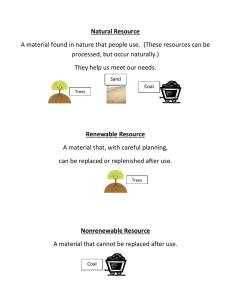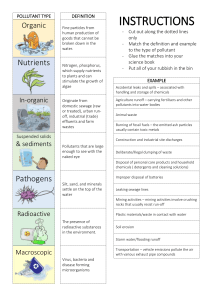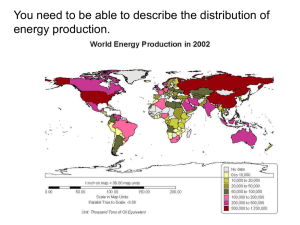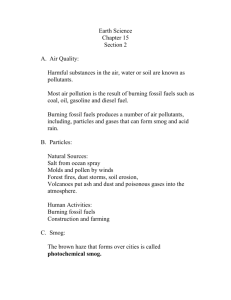2nd Semester Exam Review:
advertisement
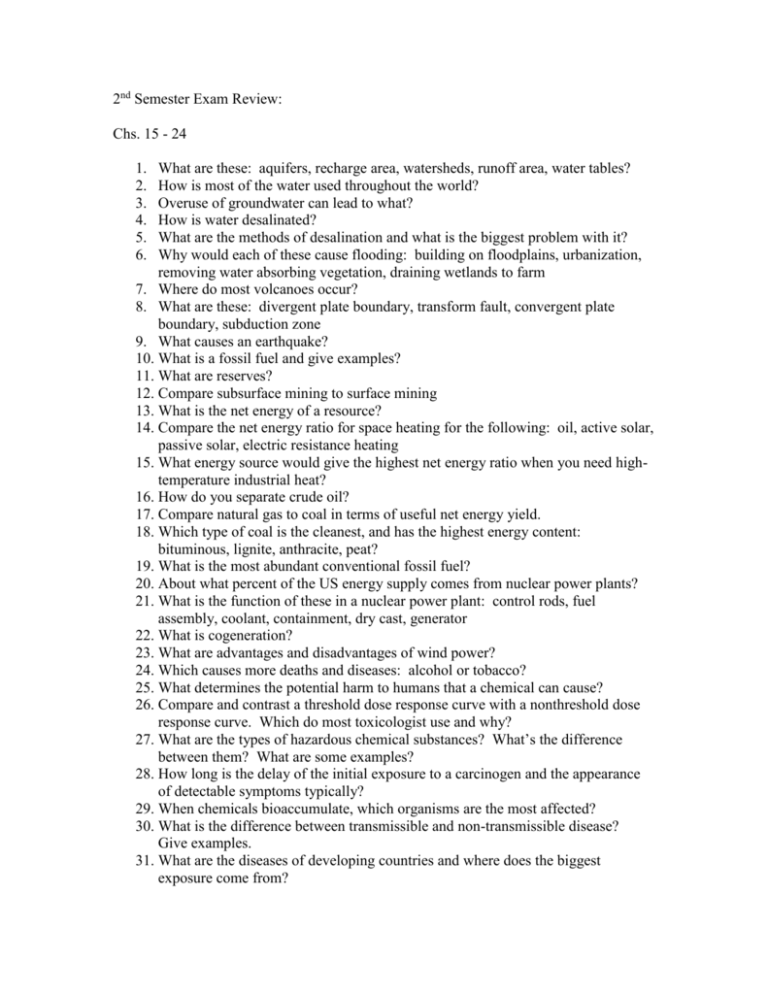
2nd Semester Exam Review: Chs. 15 - 24 1. 2. 3. 4. 5. 6. What are these: aquifers, recharge area, watersheds, runoff area, water tables? How is most of the water used throughout the world? Overuse of groundwater can lead to what? How is water desalinated? What are the methods of desalination and what is the biggest problem with it? Why would each of these cause flooding: building on floodplains, urbanization, removing water absorbing vegetation, draining wetlands to farm 7. Where do most volcanoes occur? 8. What are these: divergent plate boundary, transform fault, convergent plate boundary, subduction zone 9. What causes an earthquake? 10. What is a fossil fuel and give examples? 11. What are reserves? 12. Compare subsurface mining to surface mining 13. What is the net energy of a resource? 14. Compare the net energy ratio for space heating for the following: oil, active solar, passive solar, electric resistance heating 15. What energy source would give the highest net energy ratio when you need hightemperature industrial heat? 16. How do you separate crude oil? 17. Compare natural gas to coal in terms of useful net energy yield. 18. Which type of coal is the cleanest, and has the highest energy content: bituminous, lignite, anthracite, peat? 19. What is the most abundant conventional fossil fuel? 20. About what percent of the US energy supply comes from nuclear power plants? 21. What is the function of these in a nuclear power plant: control rods, fuel assembly, coolant, containment, dry cast, generator 22. What is cogeneration? 23. What are advantages and disadvantages of wind power? 24. Which causes more deaths and diseases: alcohol or tobacco? 25. What determines the potential harm to humans that a chemical can cause? 26. Compare and contrast a threshold dose response curve with a nonthreshold dose response curve. Which do most toxicologist use and why? 27. What are the types of hazardous chemical substances? What’s the difference between them? What are some examples? 28. How long is the delay of the initial exposure to a carcinogen and the appearance of detectable symptoms typically? 29. When chemicals bioaccumulate, which organisms are the most affected? 30. What is the difference between transmissible and non-transmissible disease? Give examples. 31. What are the diseases of developing countries and where does the biggest exposure come from? 32. What is the difference between ozone in the troposphere and ozone in the stratosphere? Where is it depleting? 33. What is photochemical smog? How is it produced and what are the necessary components? What is formed? 34. What is the difference between primary and secondary pollutants? 35. What are the primary pollutants of coal burning? Gasoline burning? 36. What is acid deposition and why is it more a regional problem? 37. What are the complications of acid deposition? 38. List the 4 most dangerous indoor pollutants and how do they harm the health? 39. What is the source of the indoor pollutants that you described above? 40. How does air pollution affect trees in higher elevations? 41. Name 5 top green house gases. Which are the top 2? Which gas is increasing the fastest and why? 42. Describe how these lead to an increase in green house gases: burning fossil fuels, Freon, deforestation, decomposition. 43. What are the side effects of global warming? 44. What tests do we do to determine water quality? Which test would mean there was a high level of sewage waste in the water? 45. What concentration of fecal coliform bacteria is allowable in drinking water? Swimming water? 46. Describe the events that occur when organic waste like sewage gets dumped into a stream? 47. Describe the events that occur when phosphates and nitrates in runoff from farm land makes its way into a stream? 48. What’s the difference between point source and non-point source of water pollution? 49. Label the oxygen sag curve. 50. What is a pest? 51. Name the types of pesticides. 52. Describe an ideal pesticide. 53. What is the most serious drawback to using chemicals to control pests?
